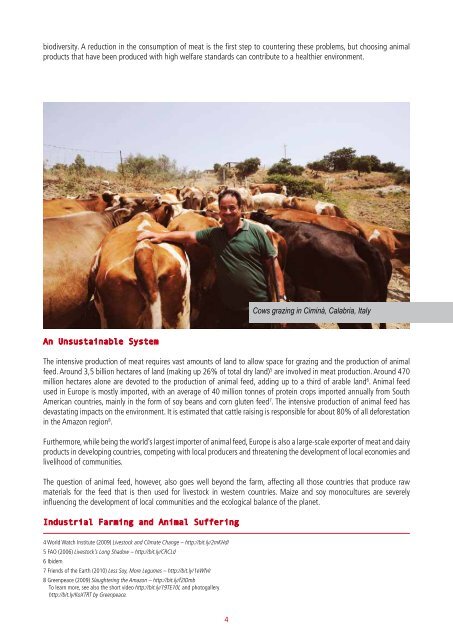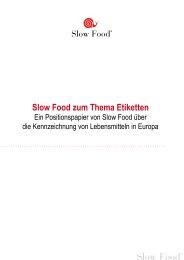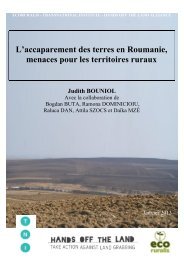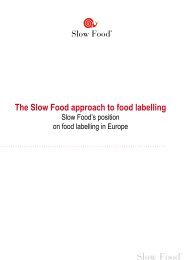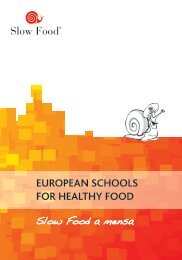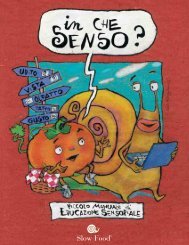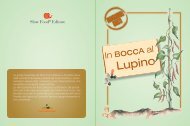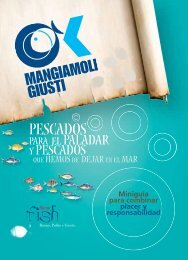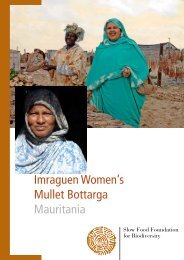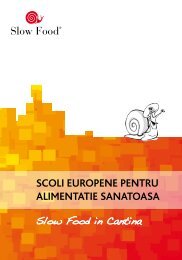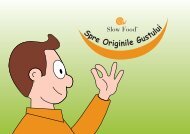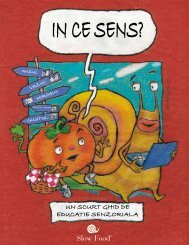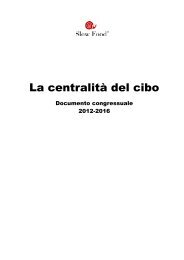Slow Food Policy Paper on Animal Welfare
Slow Food Policy Paper on Animal Welfare
Slow Food Policy Paper on Animal Welfare
Create successful ePaper yourself
Turn your PDF publications into a flip-book with our unique Google optimized e-Paper software.
iodiversity. A reducti<strong>on</strong> in the c<strong>on</strong>sumpti<strong>on</strong> of meat is the first step to countering these problems, but choosing animal<br />
products that have been produced with high welfare standards can c<strong>on</strong>tribute to a healthier envir<strong>on</strong>ment.<br />
© Alberto Peroli<br />
Cows grazing in Ciminà, Calabria, Italy<br />
An Unsustainable System<br />
The intensive producti<strong>on</strong> of meat requires vast amounts of land to allow space for grazing and the producti<strong>on</strong> of animal<br />
feed. Around 3,5 billi<strong>on</strong> hectares of land (making up 26% of total dry land) 5 are involved in meat producti<strong>on</strong>. Around 470<br />
milli<strong>on</strong> hectares al<strong>on</strong>e are devoted to the producti<strong>on</strong> of animal feed, adding up to a third of arable land 6 . <strong>Animal</strong> feed<br />
used in Europe is mostly imported, with an average of 40 milli<strong>on</strong> t<strong>on</strong>nes of protein crops imported annually from South<br />
American countries, mainly in the form of soy beans and corn gluten feed 7 . The intensive producti<strong>on</strong> of animal feed has<br />
devastating impacts <strong>on</strong> the envir<strong>on</strong>ment. It is estimated that cattle raising is resp<strong>on</strong>sible for about 80% of all deforestati<strong>on</strong><br />
in the Amaz<strong>on</strong> regi<strong>on</strong> 8 .<br />
Furthermore, while being the world’s largest importer of animal feed, Europe is also a large-scale exporter of meat and dairy<br />
products in developing countries, competing with local producers and threatening the development of local ec<strong>on</strong>omies and<br />
livelihood of communities.<br />
The questi<strong>on</strong> of animal feed, however, also goes well bey<strong>on</strong>d the farm, affecting all those countries that produce raw<br />
materials for the feed that is then used for livestock in western countries. Maize and soy m<strong>on</strong>ocultures are severely<br />
influencing the development of local communities and the ecological balance of the planet.<br />
Industrial Farming and <strong>Animal</strong> Suffering<br />
4 World Watch Institute (2009) Livestock and Climate Change – http://bit.ly/2mKHdI<br />
5 FAO (2006) Livestock’s L<strong>on</strong>g Shadow – http://bit.ly/CRCLd<br />
6 Ibidem<br />
7 Friends of the Earth (2010) Less Soy, More Legumes – http://bit.ly/1eWfvlr<br />
8 Greenpeace (2009) Slaughtering the Amaz<strong>on</strong> – http://bit.ly/f2IDmb<br />
To learn more, see also the short video http://bit.ly/19TE10L and photogallery<br />
http://bit.ly/KoXTRT by Greenpeace.<br />
4


